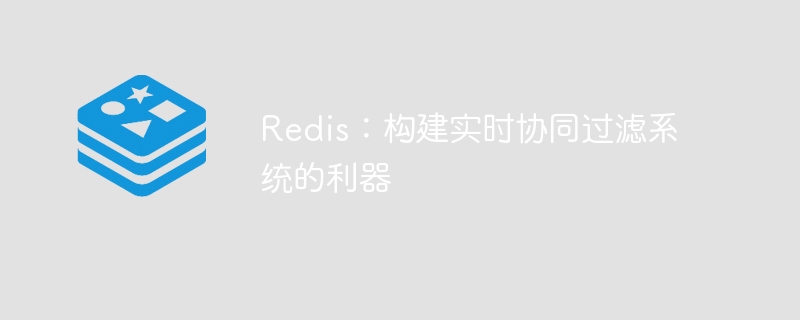
Redis is a high-performance caching and data storage system that has become a core component of many real-time collaborative filtering systems. This article will deeply explore the application of Redis in real-time collaborative filtering systems and provide code examples. I hope it will be helpful to everyone.
1. What is a real-time collaborative filtering system?
The real-time collaborative filtering system refers to recommending content that may be of interest to users based on historical data of user behavior. Such recommendations are often implemented within websites or applications, such as movie recommendations and product recommendations. This type of recommendation mainly uses the collaborative filtering algorithm, which provides recommendation results to users based on user behavior.
2. The role of Redis in real-time collaborative filtering system
Redis is mainly used in two aspects in real-time collaborative filtering system, namely caching and data storage. As an in-memory database, Redis can store large amounts of data in memory and can store historical data of user behavior. This data can be used not only for real-time recommendations, but also for offline training and model optimization.
Redis plays a vital role in real-time collaborative filtering systems. Through caching and data storage, the real-time collaborative filtering system can quickly obtain user behavior data, store recommendation results, and update the computing model in real time. During the implementation process, Redis's fast reading and writing capabilities and persistence capabilities enable the real-time collaborative filtering system to quickly respond to user requests and update recommendation results, making the user experience smoother.
3. Redis code example
Let’s take a look at how to implement Redis caching and data storage in a real-time collaborative filtering system.
1. Cache user behavior
When a user behavior occurs, such as a user watching a movie or purchasing a product, we can store this behavior in Redis. The code is as follows:
# 获取 Redis 连接
redis_conn = redis.Redis(host='localhost', port=6379, db=0)
# 将用户行为缓存到 Redis 中
def cache_user_behavior(user_id, item_id):
# 以 “用户 id:用户行为” 为键存储用户行为,值为商品 id
redis_conn.set(f"{user_id}:behavior", item_id)2. Store the trained model
In order to use the model in real-time recommendation, we need to store the trained model in Redis. The code is as follows:
# 存储模型到 Redis 中
def cache_model(model):
# 序列化模型
serialized_model = pickle.dumps(model)
# 存储序列化后的模型到 Redis 中
redis_conn.set('model', serialized_model)3. Obtain the historical records of user behavior
In order to implement the collaborative filtering algorithm, we need to obtain the historical behavior records of all users. The code is as follows:
# 获取用户行为的历史记录
def get_user_behavior(user_id):
# 从 Redis 中获取用户行为记录
behavior_record = redis_conn.get(f"{user_id}:behavior")
# 如果存在则返回
if behavior_record:
return behavior_record.decode('utf-8')
else:
return None4. Update the user’s recommendation results
In the real-time collaborative filtering system, we need to continuously update the user’s recommendation results. The code is as follows:
# 更新用户的推荐结果
def update_user_recommendations(user_id, recommendations):
# 将推荐结果缓存到 Redis 中,并设置过期时间为 1 天
redis_conn.set(f"{user_id}:recommendations", recommendations)
redis_conn.expire(f"{user_id}:recommendations", 86400)4. Conclusion
Through this article, we learned about the application of Redis in real-time collaborative filtering system and code examples. Redis can be used as the core component of the real-time collaborative filtering system to improve the performance and user experience of the recommendation system. At the same time, we also provide Redis code examples to help you better understand how to use Redis in corresponding application scenarios.
The above is the detailed content of Redis: a powerful tool for building real-time collaborative filtering systems. For more information, please follow other related articles on the PHP Chinese website!
 Commonly used database software
Commonly used database software
 What are the in-memory databases?
What are the in-memory databases?
 Which one has faster reading speed, mongodb or redis?
Which one has faster reading speed, mongodb or redis?
 How to use redis as a cache server
How to use redis as a cache server
 How redis solves data consistency
How redis solves data consistency
 How do mysql and redis ensure double-write consistency?
How do mysql and redis ensure double-write consistency?
 What data does redis cache generally store?
What data does redis cache generally store?
 What are the 8 data types of redis
What are the 8 data types of redis




